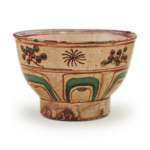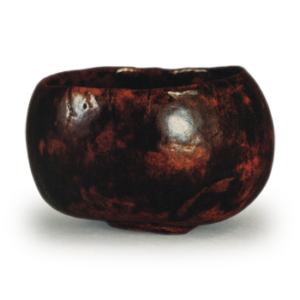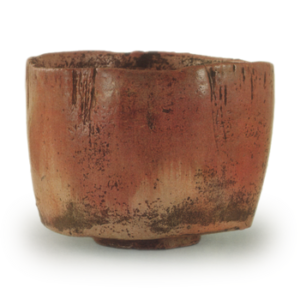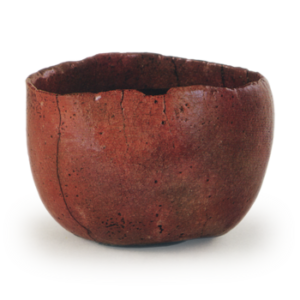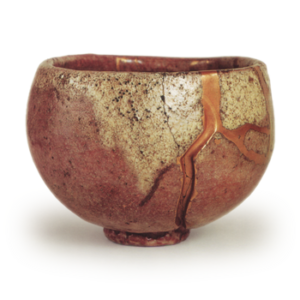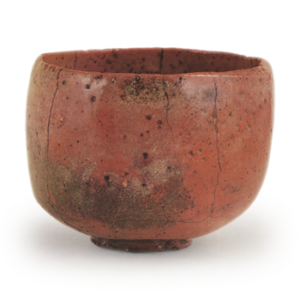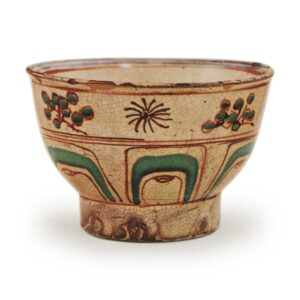
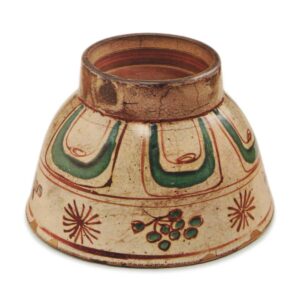
Height: 9.5cm
Diameter: 14.0-14.5cm
Outer diameter of foot ring: 7.8-8.0cm
Height of foot ring: 2.3cm
This is one of the few bowls from the Red Annam region that has particularly outstanding design.
The bowl is slightly convex, with a foot ring that is tall and large, characteristic of Annamese bowls, and the body has a pleasing fullness. It is made with a slightly thick body, giving it a solid feel. The clay is made from a sticky, fine-grained clay, and it is fired with a yellowish hue. The inside and outside are covered with a transparent glaze, but the inside of the foot ring is unglazed and coated with a brownish-red, so-called “shibugusuri” (rust-like) glaze. The glaze surface shows a rough craquelure.
On the inside and outside of the glaze, a bizarre pattern is drawn using red and green overglaze pigments. The outside is divided into two sections by a double red line, with a tree-branch motif and chrysanthemum pattern alternating on the upper section, and a six-petal lotus pattern prominently displayed on the lower section. The red is a slightly dull red unique to Beni-Anan, and the green is a clear, bright green. The vivid green, especially the thickly painted green inside the lotus petal design, is very striking. The interior is decorated with a design of characters in underglaze blue, and there are two areas of red and green patterns that look like grass or birds, with several circles of underglaze blue. The underglaze blue-black is also tinged with brown in some places, and it seems that the iron-rich gosu glaze unique to An-nan was also used.
The red An-nan ware, also known as Beni An-nan, has been found in considerable numbers in recent years in the south of China, but the only example of Beni An-nan ware that has been handed down in Japan since ancient times is the Beni An-nan tea bowl that was passed down in the Owari Tokugawa family. However, this tea bowl is also a rare relic that is said to have been passed down in an old family in the Nagoya area, or it is thought that it may have been passed down since the Edo period. Moreover, there are many similarities in the shape and style of the bowl to the Beni Anan of the Owari Tokugawa family, and it is thought that it was made in Vietnam and brought to Japan around the same time.
There are quite a few different types of An-Nan red-glazed ware, and it is not impossible to consider whether they are old or new, but at the moment, no detailed examination has been carried out. As with An-Nan blue-and-white ware, there are also relics that are thought to date from the beginning or middle of the Ming dynasty, and there is also red-glazed ware that is thought to date from the end of the Ming and beginning of the Qing dynasties.
Judging from the way they were made, these kinds of red An-Nan tea bowls are thought to have been made in the 16th or 17th century, and it is thought that they were brought to Japan around the time of the Momoyama and early Edo periods. The place of production is also not known in detail. It is probably somewhere in northern Vietnam, near Hanoi, as with the blue and white porcelain, but so far there have been no clues. All of this will have to wait for future research.
The body has a crack running around it, and the rim of the mouth has been repaired with gold in several places, but it is in almost perfect condition, and the state of the overglaze painting is also good, making it a valuable example.
(Hasebe Gakuji)

